

| Grade | Prius | |
|---|---|---|
| Model type & weight |
Model type | HK-NHW10-AEEEB |
| Curb mass(kg) | 1240 | |
| Dimensions | Length(mm) | 4275 |
| Width(mm) | 1695 | |
| Height(mm) | 1490 | |
| Wheelbase(mm) | 2550 | |
| Engine | Engine code | 1NZ-FXE |
| Engine type | Water-cooled, in-line 4-cylinder, DOHC (transverse engine) | |
| Displacement(cm3) | 1496 | |
| Max. output kW(PS)/r.p.m. | -/58/4000 |
| * | The specifications are those of representative model grades. |
| * | Max. output represents a net rating. In the above table, digits separated by slashes ( / / ) stand for kW, PS, and r.p.m., respectively. |
| * | The model numbers of these vehicles are NHW10(1500). |
| Plant | Motomachi plant [from May 2000 to July 2003], Takaoka plant [to Feb. 2000] |
|---|
"Prius" is Latin for "prior" or "previous."


















The Prius significantly reduced the energy loss through a mechanism to stop the engine when in idle, and the regenerative braking system for converting the kinetic energy into electricity when decelerating and braking. The front-engine, front-wheel-drive sedan could accommodate five passengers, and featured the uniquely proportioned design including a relatively tall body, a large cabin, short overhangs, and a centrally located instrument panel.
The initial ad copy for the Prius touted "Just in time for the 21st century," signifying that it was the forerunner of fossil fuel-free automobiles of the 21st century. While its driving performance was comparable to that of existing gasoline-powered cars, the Prius doubled the fuel efficiency and cut the CO2 emissions by half. As its export began in 2000, the Prius caught the attention of environment-conscious American consumers, with many celebrities causing a social phenomenon.
The Prius won the 1997 New Car of the Year and the 1997-1998 Car of the Year Japan.